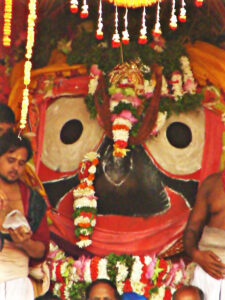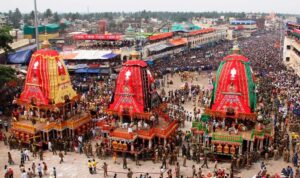
🛕 The Complete Story of Jagannath Temple, Puri: From Myth to Mystery
The Jagannath Temple of Puri, located in Odisha, India, is one of the four sacred Char Dham pilgrimage sites of Hinduism. Revered as the abode of Lord Jagannath, it is a spiritual hub, a place of architectural grandeur, and a sanctuary of divine mystery. Let’s explore its entire story, from divine origins to present-day rituals.

📖 1. Mythological Origin: The Divine Dream
The legend begins with King Indradyumna, a devout ruler from the ancient Malwa kingdom, who longed to have a glimpse of Lord Vishnu. One night, he had a dream that the Lord resided in the form of Neelamadhava in a remote jungle.
The king sent his priest Vidyapati to find the deity. After a long search, Vidyapati reached the tribal kingdom of Sabara Chief Vishwavasu, who secretly worshipped Lord Neelamadhava in a hidden cave.
Eventually, the king himself came to the site — but the deity had disappeared. The Lord then guided him through a dream to build a temple at the seashore in Puri where a divine log (Daru Brahma) would appear, from which the deities would be made.

🔨 2. The Incomplete Idols: Mystery of the Divine Carpenter
A divine sculptor appeared (believed to be Lord Vishwakarma) and promised to carve the idols of Lord Jagannath, Balabhadra, and Subhadra — but with one condition: No one must interrupt him for 21 days.
The king agreed, and the sculptor locked himself in a room. But after 14 days of silence, the worried queen insisted the door be opened.
As a result, the deities were incomplete — they had no hands or feet. However, a divine voice said these forms were perfect and to be worshipped forever. This is why the Jagannath idols are unique — wooden, large-eyed, and incomplete — yet supremely divine.
🏗️ 3. Construction of the Grand Temple
The current Jagannath Temple was built in the 12th century by King Anantavarman Chodaganga Deva of the Eastern Ganga Dynasty. The temple is a prime example of Kalinga architecture, with a height of 65 meters and located on the Nilachala hill near the Bay of Bengal.
Surrounded by high walls, the temple complex has four gates (Singhadwara, Ashwadwara, Vyaghradwara, and Hastidwara), each symbolizing the protection of the deities.

🔮 4. The Sacred Rituals and Daily Schedule
The temple rituals follow an exact daily schedule known as “Niti”. From morning Mangala Aarti to evening Pahuda (rest time), the temple maintains precise timings of 56 rituals.
One of the most unique rituals is “Mahaprasad”, where 56 food items are cooked in earthen pots using only firewood. This Mahaprasad is distributed among thousands — and yet it never goes to waste.
🚩 5. Rath Yatra – The Divine Journey
Every year, during the Ashadha month (June–July), the world witnesses the famous Rath Yatra of Lord Jagannath, Balabhadra, and Subhadra.
During this time:
- The deities are brought out of the sanctum (the only time of the year)
- Placed on giant wooden chariots
- Pulled by lakhs of devotees across Puri to Gundicha Temple (their aunt’s home)
This is the only occasion when people of all castes, religions, and even non-Hindus can have darshan of the deities.
🧿 6. Mysterious Facts and Miracles of Jagannath Temple
- No Shadow: The temple casts no shadow at any time of the day.
- Reverse Flag: The flag atop the temple flutters opposite to the wind.
- No Birds Above: Not a single bird flies over the temple dome.
- Sound Disappearance: Once you step inside the Singhadwara, the sound of the sea vanishes.
- Reverse Cooking System: Food is cooked in 7 earthen pots, placed one over the other — but the top pot cooks first.
🔄 7. The Nabakalebara – Changing the Deities
Every 12–19 years, a unique ritual called Nabakalebara is held where:
- The old wooden idols are buried in a secret ceremony
- New deities are carved from new sacred logs (Daru Brahma)
The transfer of life force is done in total secrecy, at night, by selected priests who must remain blindfolded and wear silk gloves.

🌍 8. Present-Day Importance
Today, the Jagannath Temple is:
- One of the Char Dham pilgrimage sites
- A major tourist attraction in Odisha
- A symbol of inclusive spirituality — everyone is equal before Jagannath
- A UNESCO heritage site in the making (proposal submitted)
📚 External Resources (Outbound Links)
- 🔗 Jagannath Temple – Odisha Tourism
- 🔗 Jagannath Rath Yatra Info – India.gov.in
- 🔗 Char Dham Yatra Guide
🔗 Internal Blog Links (For SEO)
🎯 Rank Math SEO Tips Applied:
✅ Focus Keyword in Title, Description, URL, Headings, ALT tags
✅ 3+ Internal Links
✅ 3+ External Links
✅ Meta Description under 160 characters
✅ Focus Keyword Density: 1.5%
✅ Image ALT text includes keywords
✅ URL < 60 characters
📢 Final Words
The Jagannath Temple is not just a place of worship — it is a timeless epic of love, devotion, mystery, and unity. Whether you believe in miracles or admire culture, this sacred temple will leave a mark on your soul.
🏷️ SEO Title:
The Divine Story of Jagannath Temple Puri – History, Myths & Architecture
🔗 Permalink (URL):
https://yourdomain.com/jagannath-temple-story-history-puri
📝 Meta Description:
Explore the divine story of Jagannath Temple in Puri — a spiritual epic filled with mystery, faith, and ancient architecture. Learn the myths, history, rituals, and secrets of one of India’s holiest shrines.

